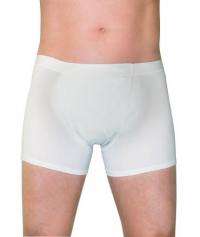New solution for a sensitive problem

Swiss scientists at Empa have worked with the industrial partner Incosan GmbH to develop a multi-layer pad and special briefs to make daily life easier for people suffering from incontinence. The products recently came onto the market.
The population is getting older, so society is increasingly having to deal with age-related complaints and their effects. Incontinence is an unpleasant and frequent problem often, but not only, experienced by the elderly. It ranges from the mild form of droplet incontinence right through to a complete loss of bladder control. Although nappies or special absorbent sanitary towels can be of help, these can often show under clothing or give themselves away by rustling during movements. Those affected also find the feeling of wetness, the cooling associated with this, and the smell of urine unpleasant.
One idea to minimise the effects of this irritating problem was devised by Peter Gloor, who has been working in this field for 20 years and has learnt a great deal about the needs and wishes of those affected via his distribution partners. He approached Empa researcher Markus Weder from the Protection and Physiology laboratory who helped him to realise his idea. Specifically, the idea was to develop a reusable pad that works according to what is known as the waterfall principle. This means that the urine passes away from the body through spacer fabric into an absorbent layer. This prevents cooling, and there is no feeling of wetness since the liquid cannot get back onto the skin again once it is absorbed. At least that’s the theory – in practice, the first design failed as the urine was absorbed and retained by the hydrophilic spacer fabric itself, so it was unable to pass into the absorbent layer.
An ingenious system for a sensitive problem
It was thus clear that hydrophobic spacer fabric would have to be used. The fabric itself should not absorb liquid, so that it feels dry. It is covered with holes, through which the droplets flow in order to be captured by the absorbent layer below. It wasn’t easy to find the right size holes. If the holes are too small, the urine droplets cannot flow through, so they stay on top of the spacer fabric, explains Weder.
The Empa team measured the effect of the pad using an infrared camera. The hydrophobic pad only cooled by one degree and was still around 30 degrees warm, which was rated as pleasant in tests involving subjects who provided feedback about their subjective evaluations. In addition, various absorbers can be inserted into the pad cover with the spacer fabric – both reusable ones and cost-effective disposable sanitary towels. The cover can also be washed and reused.
The pad does, however, not provide 100% leakage protection; as it does not feature cuffs, such as those found in nappies, the liquid can «overflow» if there are large quantities of urine. To solve this problem, Weder and his team have developed close-fitting, breathable briefs, similar to sports shorts, which can be worn underneath everyday clothes. A waterproof membrane prevents urine from escaping. Only water vapor diffuses through, thus enabling the briefs to dry slowly. This reduces the amount of odor that escapes.
















